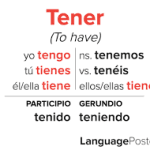Are you struggling to conjugate the verb ‘ver’ in Spanish? Look no further!
In this article, we’ll show you how to master the present, past, future, conditional, and imperative tenses of ‘ver’.
Say goodbye to confusion and hello to fluency as we guide you through each conjugation.
Don’t waste any more time – let’s dive in and conquer ‘ver’ together!
Present Tense Conjugation of ‘Ver
To conjugate ‘ver’ in the present tense, you simply need to take the abstract noun ‘you’ and add the appropriate ending.
The present tense conjugation of ‘ver’ is straightforward and follows a regular pattern. For the singular form, when referring to ‘you’, you’d use the ending ‘-es’. For example, ‘tú ves’ means ‘you see’.
In the plural form, when addressing a group of people as ‘you’, the ending changes to ‘-en’. Therefore, ‘ustedes ven’ translates to ‘you all see’.
Remember that ‘ver’ means ‘to see’, so when conjugating this verb in the present tense, keep in mind the subject pronoun and the corresponding ending.
With practice, conjugating ‘ver’ will become second nature to you.
Past Tense Conjugation of ‘Ver
In the past tense conjugation of ‘ver’, when referring to yourself, you’d use the ending ‘-iste’. This ending is used when you want to say ‘you saw’ in Spanish. Here are some examples of how to conjugate ‘ver’ in the past tense:
- Tú viste: You saw
- Usted vio: You (formal) saw
- Vosotros/vosotras visteis: You all saw
When using the past tense conjugation of ‘ver’, it’s important to remember the specific endings for each pronoun. By using the correct ending, you can accurately express past actions related to seeing.
Practice conjugating ‘ver’ in the past tense to improve your Spanish fluency. Keep in mind that regular verbs in Spanish follow similar patterns, so mastering the conjugation of ‘ver’ can help you with conjugating other verbs as well.
Future Tense Conjugation of ‘Ver
You will often use the future tense conjugation of ‘ver’ to express actions that will happen in the future. To form the future tense of ‘ver’ in Spanish, you’ll need to use the appropriate conjugation of the verb ‘ver’ followed by the future tense endings.
For example, if you want to say ‘you will see,’ you’d say ‘verás.’ If you want to say ‘we will see,’ you’d say ‘veremos.’
The future tense conjugation of ‘ver’ is used to talk about future plans, intentions, or predictions. It allows you to express what you’ll see or witness in the future. Remember to use the correct verb form and ending to accurately convey the future action of seeing.
Conditional Tense Conjugation of ‘Ver
Use the future tense conjugation of ‘ver’ to express actions that will happen in the future.
Now let’s move on to discussing the conditional tense conjugation of ‘ver’.
In the conditional tense, ‘ver’ is conjugated as follows:
- Tú verías: You’d see
- Tú no verías: You wouldn’t see
- ¿Verías tú?: Would you see?
The conditional tense is used to express hypothetical or unreal situations. It’s often used to talk about actions that would happen under certain conditions or to make polite requests.
For example, ‘Si tuviera tiempo, vería la película’ means ‘If I’d time, I’d watch the movie.’
It’s important to note that the conditional tense of ‘ver’ is irregular and doesn’t follow the regular conjugation patterns of other verbs.
Imperative Tense Conjugation of ‘Ver
Moving on to the imperative tense conjugation of ‘ver’, let’s now explore how to command someone to see something in Spanish.
In order to give a command in the second person, we use the imperative form of the verb. To command someone to see, we say ‘Ve’ for the singular ‘you’ and ‘Vean’ for the plural ‘you all’. These forms are derived from the present tense conjugation of ‘ver’.
For example, if you want to command someone to see a movie, you’d say ‘Ve la película’ for a singular command, or ‘Vean la película’ for a plural command.
It’s important to note that the pronoun ‘tú’ isn’t necessary when using the imperative form. So, next time you want to tell someone to see something in Spanish, remember to use the imperative form of ‘ver’.
Frequently Asked Questions
What Is the Meaning of the Spanish Verb ‘Ver’?
The meaning of the Spanish verb ‘ver’ is ‘to see’. It is an irregular verb that you will need to conjugate differently depending on the subject of the sentence.
Are There Any Irregular Conjugations for the Verb ‘Ver’ in the Present Tense?
Yes, there are irregular conjugations for the verb ‘ver’ in the present tense. You need to know these irregularities to properly conjugate ‘ver’ in Spanish.
How Do You Conjugate the Verb ‘Ver’ in the Subjunctive Mood?
To conjugate the verb ‘ver’ in the subjunctive mood, you use the present subjunctive form. Drop the ‘o’ and add ‘as’, ‘a’, ‘amos’, ‘áis’, or ‘an’ to the stem ‘ve’.
Can the Verb ‘Ver’ Be Used Reflexively in Spanish?
Yes, the verb ‘ver’ can be used reflexively in Spanish. To conjugate it in the present tense, you would say ‘te veo’ which means ‘I see you.’
Are There Any Idiomatic Expressions or Common Phrases That Use the Verb ‘Ver’?
There are several idiomatic expressions and common phrases that use the verb ‘ver’ in Spanish. Some examples include ‘ver para creer’ (seeing is believing) and ‘a ver’ (let’s see).
Conclusion
In conclusion, conjugating the verb ‘ver’ in Spanish is essential for effective communication. Whether it’s the present, past, future, conditional, or imperative tense, mastering the conjugations will allow you to express yourself accurately.
By understanding how to conjugate ‘ver’, you can confidently talk about seeing things in different time frames and give commands.
So, keep practicing and soon you’ll be a pro at conjugating ‘ver’ in Spanish!


